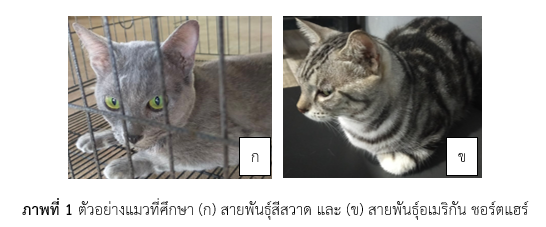การเปรียบเทียบแคริโอไทป์และเฮเทอโรมอร์ฟิซึมของตำแหน่งนิวคลีโอลาร์ ออร์แกไนเซอร์ ระหว่างแมวไทยสีสวาดและแมวสายพันธุ์ต่างประเทศอเมริกัน ชอร์ตแฮร์ ในสกุลเฟลิส (Genus Felis)
Main Article Content
บทคัดย่อ
การศึกษาเปรียบเทียบแคริโอไทป์และเฮเทอโรมอร์ฟิซึมของตำแหน่งนิวคลีโอลาร์ ออร์แกไนเซอร์ระหว่าง แมวไทยและแมวสายพันธุ์ต่างประเทศ ในสกุลเฟลิส (Genus Felis) เตรียมโครโมโซมโดยวิธีการเพาะเลี้ยงเซลล์ลิมโฟไชต์ วิเคราะห์โดยใช้เทคนิคการย้อมสีแบบโครโมโซมมาตรฐานและเทคนิคการย้อมแถบโครโมโซมแบบเอ็นโออาร์ ผลการศึกษาพบว่าแมวไทยและแมวสายพันธุ์ต่างประเทศมีจำนวนโครโมโซมแบบดิพลอยด์เท่ากับ 38 (2n=38) และจำนวนแขนโครโมโซมพื้นฐาน (fundamental number, NF) เท่ากับ 72 ทั้งในเพศผู้และเพศเมีย แคริโอไทป์แบ่งตามขนาดและรูปร่างโครโมโซมแบ่งออกเป็น 6 กลุ่ม (A-F) และพบเครื่องหมายโครโมโซมที่มีลักษณะเป็นกระเปาะ (satellite) ที่ส่วนปลายแขนข้างสั้นของโครโมโซมคู่ที่ 1 ในกลุ่ม E หรือโครโมโซมคู่ที่ 14 ทั้งในแมวไทยและแมวสายพันธุ์ต่างประเทศ ในการวิเคราะห์ด้วยเทคนิคการย้อมแถบโครโมโซมแบบเอ็นโออาร์ ตรวจพบตำแหน่งเอ็นโออาร์บริเวณโครโมโซมคู่ที่ 1 ในกลุ่ม E ในแมวทั้งสองสายพันธุ์ โดยแมวทั้งสองสายพันธุ์นี้มีจำนวนโครโมโซมดิพลอยด์เท่ากันและมีรูปแบบแคริโอไทป์มีความคล้ายคลึงกันมาก แสดงให้เห็นว่าโครงสร้างพันธุกรรมในระดับโครโมโซมของแมวไทยและแมวสายพันธุ์ต่างประเทศอยู่ในสภาพอนุรักษ์สูง แต่อย่างไรก็ตามตรวจพบความแปรผันของปริมาณการติดสีซิลเวอร์ ไนเตรต ที่ตำแหน่งเอ็นโออาร์แตกต่างกันในแต่ละตัวอย่างที่ศึกษา ความผันแปรทางพันธุกรรมที่ เกิดขึ้นนี้ส่งผลทำให้เกิดความหลากหลายทางพันธุกรรมของสัตว์ในวงศ์ฟีลิดีมากขึ้น
Article Details

อนุญาตภายใต้เงื่อนไข Creative Commons Attribution-NonCommercial-NoDerivatives 4.0 International License.
วารสารวิทยาศาสตร์และวิทยาศาสตร์ศึกษา (JSSE) เป็นผู้ถือลิสิทธิ์บทความทุกบทความที่เผยแพร่ใน JSSE นี้ ทั้งนี้ ผู้เขียนจะต้องส่งแบบโอนลิขสิทธิ์บทความฉบับที่มีรายมือชื่อของผู้เขียนหลักหรือผู้ที่ได้รับมอบอำนาจแทนผู้เขียนทุกนให้กับ JSSE ก่อนที่บทความจะมีการเผยแพร่ผ่านเว็บไซต์ของวารสาร
แบบโอนลิขสิทธิ์บทความ (Copyright Transfer Form)
ทางวารสาร JSSE ได้กำหนดให้มีการกรอกแบบโอนลิขสิทธิ์บทความให้ครบถ้วนและส่งมายังกองบรรณาธิการในข้อมูลเสริม (supplementary data) พร้อมกับนิพนธ์ต้นฉบับ (manuscript) ที่ส่งมาขอรับการตีพิมพ์ ทั้งนี้ ผู้เขียนหลัก (corresponding authors) หรือผู้รับมอบอำนาจ (ในฐานะตัวแทนของผู้เขียนทุกคน) สามารถดำเนินการโอนลิขสิทธิ์บทความแทนผู้เขียนทั้งหมดได้ ซึ่งสามารถอัพโหลดไฟล์บทความต้นฉบับ (Manuscript) และไฟล์แบบโอนลิขสิทธิ์บทความ (Copyright Transfer Form) ในเมนู “Upload Submission” ดังนี้
1. อัพโหลดไฟล์บทความต้นฉบับ (Manuscript) ในเมนูย่อย Article Component > Article Text
2. อัพโหลดไฟล์แบบโอนลิขสิทธิ์บทความ (Copyright Transfer Form) ในเมนูย่อย Article Component > Other
ดาวน์โหลด ไฟล์แบบโอนลิขสิทธิ์บทความ (Copyright Transfer Form)
เอกสารอ้างอิง
Arslan, A. and Zima, J. (2014). Karyotypes of the mammals of Turkey and neighbouring regions: a review. Folia Zoologica, 63(1), 1–62.
Biodiversity-Based Economy Development Office (2014). Thai cat (in Thai) Retrieved 4 May 2020, from intangible cultural heritage: https://www.mculture.go.th/samutsongkhram/ewt_dllink.php?nid =741
Chavananikul, V., Wattanodorn, S. and Nuanualsuwan, S. (1994). Karyotypes of tiger and panther, In Proceedings of the 32nd Kasetsart University Annual Conference: Animal Science, Veterinary Science and Fisheries. (pp. 286-294). Bangkok: Kasetsart University.
Cho, E. J., Kong, I. K. and Sohn, S. H. (2013). The G-, C-, and NOR-Banded Karyotypes of Korean Short-hair Cat (Felis catus). Reproductive & Developmental Biology, 37(3), 161-167.
De Lorenzi, L., Banco, B., Previdere, C., Bonacina, S., Romagnoli, S., Grieco, V. and Parma, P. (2017). Testicular XX (SRY-Negative) Disorder of Sex Development in Cat. Sexual Development, 11(4), 210-216.
Ford, C. E., Pollock, D. L. and Gustavsson, I. (1980). Proceedings of the First International Conference for the Standardisation of Banded Karyotypes of Domestic Animals. Hereditas, 92(1), 145-162.
Ghotage, D., Umrikar, U. D., Sawane, M. P. and Pawar, V. D. (2019). Cytogenetic Analysis in Domestic Cats. International Journal of Sciences: Basic and Applied Research, 47(1), 141-146.
Gold, J. R. (1984). Silver-Staining and Heteromorphism of Chromosomal Nucleolus Organizer Regions in North American Cyprinid Fishes. American Society of Ichthyologists and Herpetologists (ASIH), 23(1), 133-139.
Goodpasture, C. and Bloom, S. E. (1975). Visualization of nucleolar organizer regions in mammalian chromosomes using silver staining. Chromosoma, 53(1), 37–50.
Gustavsson, I. (1965). Somatic chromosomes of the cat. Acta Veterinaria Scandinavica, 6(3), 274-285.
Howe, B., Umrigar, A. and Tsien, F. (2014). Chromosome preparation from cultured cells. Journal of Visualized Experiments, 83(1), 1-5.
Hsu, T. C. and Benirschke, K. (1976). An Atlas of Mammalian Chromosomes. Wiley Online Library, 23(7), 616-616.
Kalat, M., Mayr, B. and Schleger, W. (1990). Sequential Counterstain enhanced Banding: Heterochromatin Characterization in The Domestic Cat (Felis catus). Caryologia, 43(2), 183-198.
Keawmad, P., Tanomtong, A. and Khunsoon, S. (2007). A study on karyotype of the Asian leopard cat, Prionailurus bengalensis (Carnivora, Felidae) by Conventional staining, G-banding and high-resolution technique. Cytologia, 72(1), 101-110.
Kitchener, A. C., Breitenmoser-Würsten, C., Eizirik, E., Gentry, A., Werdelin, Lars, Wilting, A., Yamaguchi, N., Abramov, A. V., Christiansen, P., Driscoll, C., Duckworth, J. W., Johnson, Warren E., Luo, S. J., Meijaard, E., O'Donoghue, P., Sanderson, J., Seymour, K., Bruford, M., Groves, C., Hoffmann, M., Nowell, K., Timmons, Z. and Tobe, S. (2017). A revised taxonomy of the Felidae: The final report of the Cat Classification Task Force of the IUCN/SSC Cat Specialist Group. Cat News, 11(1), 1-80.
Lyons, L. A. (2012). The Feline Genome and Clinical Implications. Elsevier Public Health Emergency Collection, 1(1), 1263–1269.
Pearson, M. D., Seabright, M. and Maclean, N. (1979). Silver staining of nucleolar organizer regions in the domestic cat, Felis catus. Cytogenetics and Cell Genetics, 24(4), 245-247.
Rooney, D. E. (2001). Human cytogenetics: constitutional analysis. Oxford: Oxford University Press.
Sansag, S., Tanomtong, A., Pimpun, S. and Patawang, I. (2017). Cytogenetics of Leopard Cat (Prionailurus bengalensis) in Thailand by Conventional Staining and NOR Banding Techniques. Koch Cha Sarn Journal of Science, 39(2), 96-108.
Tanomtong, A., Khunsook, S., Keawmad, P. and Siripiyasing, P. (2008). Karyological Study of the Jungle Cat, Felis chaus (Carnivora, Felidae) by Conventional Staining, G-banding and High-resolution Staining Technique. Cytologia, 73(1), 61-70.
Tosihide, H. Y. and Kyoko, K. (1982). Chromosomal alteration and the development of tumors. XXVI. A mammary cancer of the domestic cat characterized by hypodiploid and hypotetraploid modes, with a special note on increase of diploid cells after deep freezing. The Japanese Journal of Genetics, 58(1), 1-9.


